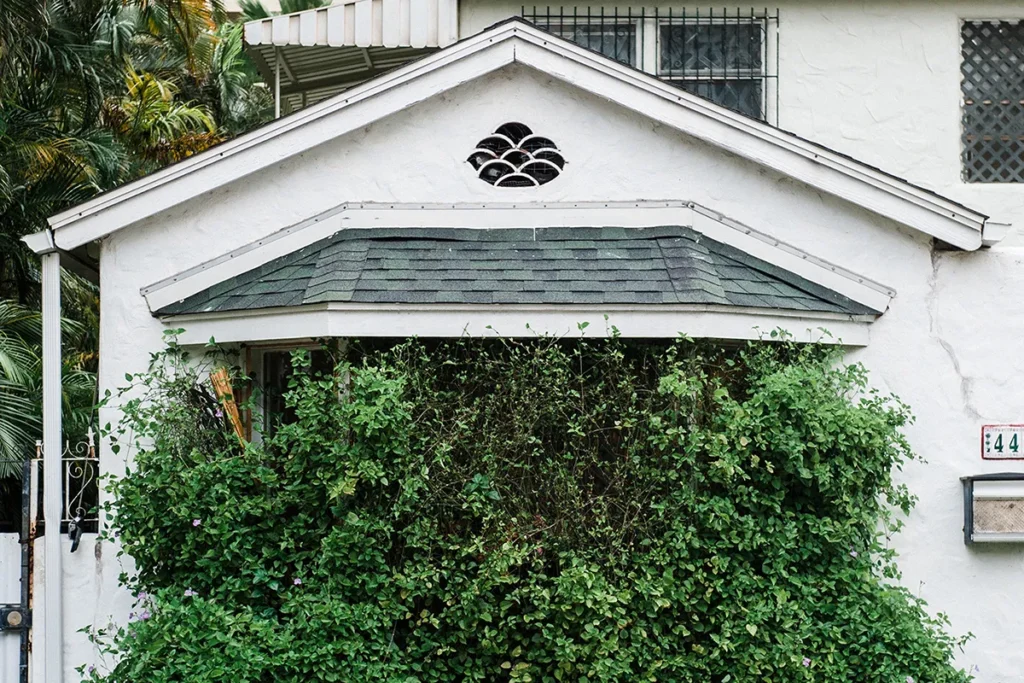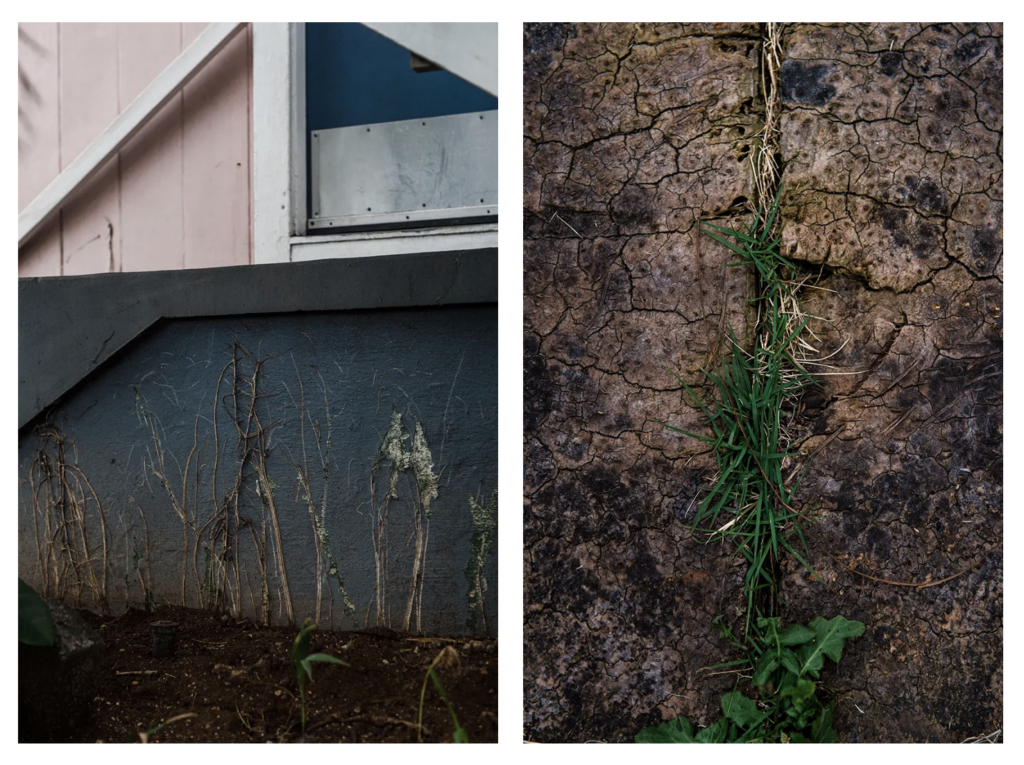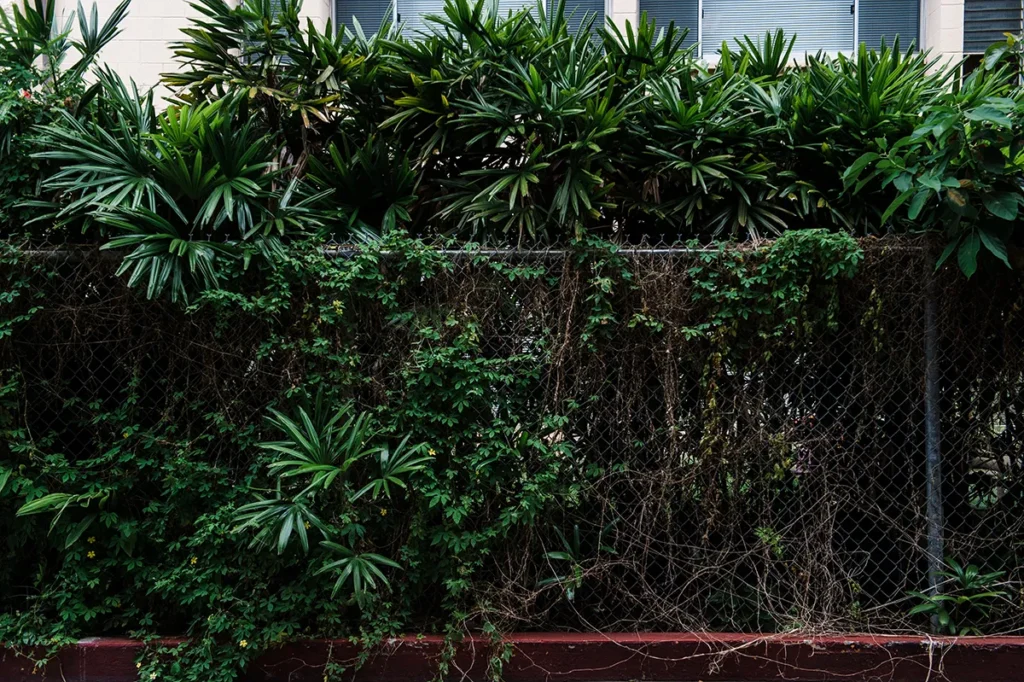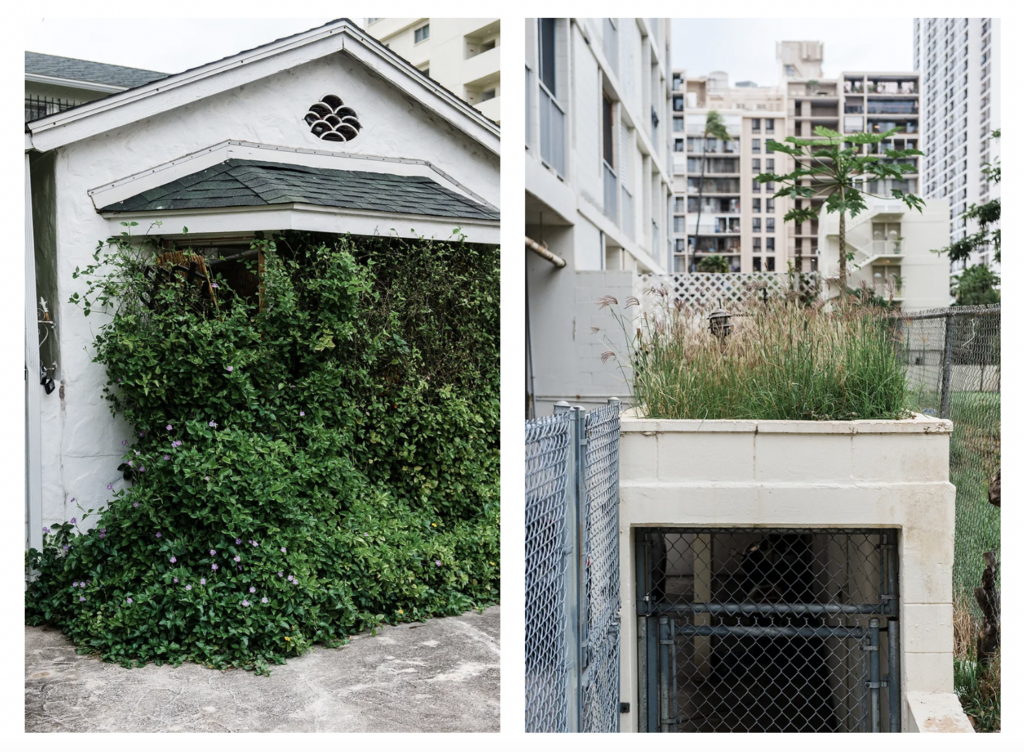Vacant and destitute to the eye, upon closer inspection our citiesʻ fallow spaces are brimming with much-needed lessons. During this past year of isolation, these passed-over realms can be our greatest classroom.

Two blocks from the apartment my wife and I share in Waikīkī is a vacant lot surrounded by a chain-link fence. On a block otherwise crowded with high-rises and walk-up apartments, the lot sticks out. It’s big enough for three or four houses. And yet it is remarkable not only for what is absent but for what is present. Inside the fence, rows of steel rebar cut across the lot at right angles, like windbreaks made from tiny metal trees. The rebar is four feet tall in places and, in its orthogonal arrangement, creates the illusion of space, demarcating rooms in the buffelgrass. Perfect geometries overlaid onto a landscape of rubble.
I go out of my way to walk by this lot. It has the feeling of an art installation. In places, dirt has been mounded up into odd, grass-covered hillocks, leaving excavated areas that fill up with water when it rains, forming square, bedroom-sized ponds. In one corner is a solitary coconut palm. In the other, a dead mango tree.
I imagine the artist’s statement, citing the record set in March 2021 when the median price of a house on O‘ahu climbed to $920,000 despite the pandemic. The installation is a commentary on housing insecurity in Hawai‘i, on all the families financially underwater.
I do not know who is responsible for this ghost house made of rebar, what it was intended to be, or when it was installed. Whether it is the remains of a structure or the opposite—its nascent, stalled beginnings. What I do know is that for the past six years, the lot has sat there. Empty but for its maze of steel. The phantom outline of a future that never was.

Vacant lots are omnipresent in cities. By one estimate, 15 percent of developable land in American cities is vacant. In Honolulu, excluding land too steep to build on, 590 acres are classified as vacant. “Unimproved,” this land is called.
I’ve spent a good portion of the coronavirus pandemic thinking about vacant lots—these weedy, overgrown spaces in our cities that seem to be contributing nothing—and whether they might hold lessons for our present moment.
A few years ago, I interviewed landscape theorist Jill Desimini about the phenomenon of vacancy in U.S. cities. Desimini doesn’t like the word “vacant.”
She prefers “abandoned” or, better yet, “fallow,” a reference to the centuries-old practice in which a farmer leaves a field unplanted for a season, allowing nutrients in the soil to be replenished.
A lot with no house on it is rarely truly vacant, Desimini told me. There are myriad, often invisible activities taking place in such spaces. Weeds and volunteer trees, which spring from seeds dropped by birds or the breeze, can store carbon and filter air pollution. They can nourish denuded soils and absorb rainwater. Many play a surprising role in supporting urban ecosystems.
A study of “urban spontaneous vegetation” in Halifax, Nova Scotia, found that vacant lots were more biodiverse and attracted higher numbers of invertebrates such as butterflies than lawns or even urban forests. Some plant species we call “weeds” can even remove pollutants from contaminated soils, an act known as phytoremediation.
Our economic system places no value on these so-called ecosystem services, just as it places little to no value on activities that are not transparently productive, like recreation or rest. But the pandemic has taught me that, like weeds whose contributions to urban life largely go unrecognized, the hours we spend not producing may be more important than we realize.
In a 2019 op-ed for the New York Times titled “You Are Doing Something Important When You Aren’t Doing Anything,” writer Bonnie Tsui made a case for the necessity of fallow time as a regular part of a creative practice.
“Fallow time is necessary to grow everything from actual crops to figurative ones, like books and children,” she wrote. “To do the work, we need to rest, to read, to reconnect. It is the invisible labor that makes creative life possible.”
When I first read these words, in the innocent days of summer 2019, I liked the idea of fallow time, felt the truth of it. Like Tsui, however, I struggled with the sense of guilt that can accompany fallow time activities: idly staring out the window, taking a walk or a nap during the workday, any of the small snatches of rest we reclaim from the busyness of life. Writing, my brain told me, meant putting words on a page. If I wasn’t doing that, was I really working?
Then a global pandemic sent me and hundreds of millions of other people into quarantine. For a lot of artists and writers, the fallout was immediate. Without the ability to travel, writing projects evaporated. Companies paused their ad-buys, hollowing out editorial budgets, and the overwhelming urgency of the crisis introduced new hierarchies for determining what was newsworthy. As a result, the amount of work I had on any given day dwindled. I applied for unemployment benefits and, in my more melodramatic moments, wondered what my next career would be. What kind of job was a plant nerd with zero hard skills qualified for?
Forced into a fallow period, I began to give myself over to a slower pace. I filled my days with walks around my neighborhood, my nights with old movies. I started a journal, mostly a catalog of small joys, and got incrementally better at meditating, though many mornings I simply watched the terns wheeling over Kapahulu Avenue and envied their freedom.
On my walks, I took a copy of Pratt’s Pocket Guide to Hawai‘i’s Trees and Shrubs and taught myself the name of any tree that was unfamiliar to me. The one whose large, almond-shaped seeds I dodged on my runs around Diamond Head was Terminalia catappa, or tropical almond, known variously as false kamani, ketapang, and story tree. The gangly one with the pink, tentacle-like flowers was Brassaia actinophylla, also known as octopus tree and classified in Hawai‘i as a weed.
Near the edge of Kapi‘olani Park were massive Ficus macrophyllas, or Moreton Bay figs, their thick, magnolia-like leaves conjuring distant memories of a week spent wandering the streets of New Orleans.
As I walked, some part of me—maybe it was my entire body?—began to unclench. I described the feeling to someone in book terms: Pre-pandemic life had felt like a page with only the thinnest of margins. In quarantine, paradoxically, life became a poem. Everything was white space.

I pictured these fallow-time activities as weeds colonizing a vacant lot, sprung from cracks pried open by quarantine, their worth masked by a culture that values only productivity.
“Protecting and practicing fallow time is an act of resistance; it can make us feel out of step with what the prevailing culture tells us,” Tsui writes. This is, in essence, also the gospel preached by the Nap Ministry, an activist organization created by the Black performance artist and theologian Tricia Hersey, who frames rest as a “divine right” that people of color, specifically Black people, have been denied for centuries.
The notion of lying fallow reminds us that our personal resources are limited. In arid areas, fallowing preserves the moisture in the soil for the season when crops are planted. We need to start acknowledging that our own energies—our mental, emotional, and spiritual resources—are finite too.
The pandemic has forced many of us to reevaluate our relationships to productivity. I’ve come to see that our cultural and aesthetic preference for landscapes that are neat and tidy is part of a larger cult of order and optimization.
Weeds intrude on the narrative that we have it all together. We may not always recognize what a particular fallow period—whether an afternoon, or the interminable pause in which we currently find ourselves—is providing. But claiming time for ourselves is, itself, an act of liberation. As the artist Anne Percoco put it, “Weeds serve their own purposes.”
At some point in the past year, reality and metaphor merged, and with the help of a newly downloaded plant-identification app called Seek, I began learning the names not only of the trees I passed but of the weeds too.
There was scarlet spiderling and bellyache bush (which gets its name for toxic compounds that pervade every fiber of the plant), old world diamond flower, and graceful spurge. I found wineflower, tasselflower, and corkystem passionflower.
Most were foreign to me, but a few, like cabbage and sorghum—both found along the edge of Kapi‘olani Park—were surprisingly common, and wouldn’t be considered weeds at all were they not growing on the side of the road. One day, I discovered a baby bodhi tree, that totem of enlightenment, no more than three inches tall and growing out of a black asphalt sea.
What we call a weed has always been a matter of culture, not botany. Recently, artists and ecologists have worked to rebrand these little-loved species.
Books like Peter del Tredici’s Wild Urban Plants of the Northeast: A Field Guide recasts weeds as spontaneous urban vegetation, while the Next Epoch Seed Library, founded by Anne Percoco and Ellie Irons in 2015, is a genetic repository of “tough, highly adaptable” plant species “well-suited to live in close quarters with humans and their attendant landscape transformations.”
Poet Regan Good, who also spent quarantine cataloging the wild urban plants around her, writes that she could not help but admire the resilience of “plucky, scrappy, ingenious, tenacious” individuals growing out of wrought-iron fences, concrete curbs, and brick facades. In their adaptive ability to survive in hostile conditions, she found a kind of kinship. “In a weed’s natural calling to survive,” she writes, “one recognizes oneself.”
The need to recognize the value of fallow time, individually and collectively, extends beyond our present moment or the needs of creative practice.
One of the most disorienting aspects of the pandemic has been the need for those of us stuck at home (and without young kids) to square the languid pace of life in quarantine with the horrifying realities being lived by the doctors, nurses, farmers, delivery drivers, and all the other “essential” workers who make our fallow periods possible.
Even now, with case counts falling in Hawai‘i and the daily tally of persons vaccinated inching upward, it is hard not to think of all that has been lost.
But rest is a political act, as is reclaiming our attention from an economic and political system that would commodify it. In How To Do Nothing, Jenny Odell argues that refusing to engage with the attention economy on its terms and instead retraining our attention on our neighbors—be they the elderly couple downstairs or the white terns down the street—is one basis for collective action.
“It is with acts of attention that we decide who to hear, who to see, and who in our world has agency,” Odell writes. “If it’s true that collective agency both mirrors and relies on the individual capacity to pay attention, then in a time that demands action, distraction appears to be (at the level of the collective) a life-and-death matter.”
In ecology, a sudden event that alters the underlying makeup of an ecosystem is known as a “disturbance.” Disturbance can come from wildfire, human development, disease.
The ecology of a vacant lot is defined by disturbance, and the weeds that thrive there do so because they are uniquely adapted to degraded or even toxic environments. Writer and landscape architect Sean Burkholder speculates that it is these species that will form the backbone of tomorrow’s urban ecosystems. As urbanization causes plants and animals and bacteria to adapt and change, novel ecologies will form.
The past year brought incalculable loss. But the disturbance created by the coronavirus also gave rise to new physical and virtual networks—human ecosystems—of medical testing and contact tracing, political organizing and mutual aid. How many more novel ecosystems—made up of artists, organizers, educators, activists—will grow from the weeds of this forced fallow time?
Fallow periods can feel like an end. If we’re lucky, we’ll have people in our lives who will counsel patience and remind us of the life-giving work happening below the surface. For me, the slow days of early quarantine gave way to a vigorous crop of new ideas. The rough contours of a book idea germinated.
Dormant memories surfaced, raising questions I resolved to explore in future writings. The roots of the weeds I had allowed to grow pried open new and larger cracks, creating space for yet more species, more fallow-time activities.
As these things happened, I noticed the shape of my day changed in response. I was making more time to meditate, more time to rest. As Tsui promised, a period of “furious output” followed a period of “faithful input.”

Recently, I went back through the journal I’ve kept since last March. The word “fallow” first appears on April 10, 2020. I’ve continued to gravitate to that word because, while it describes the present, it implies a future: a period of renewed vigor, fed by nutrients replenished over the course of the fallow season.
Some days, it was hard to trust that such a period would come, as shock wave after shock wave of disease tore through communities and a callous president stood by. Some days, hope felt naive.
When I feel that way, because I still do some days, I turn to the page in my journal where I stuck a little, blue Post-It note. “Remember the value of weeds,” it reads. And I am reminded that it is from the cracks of a broken world that new realities and possibilities will sprout.
Originally published in FLUX Hawaiʻi in 2021.